“Showdown”
Story by Kevin Altieri, Paul Dini, Bruce W. Timm
Teleplay by Joe R. Lansdale
Directed by Kevin Altieri
Episode #078
Music Composed by Tom Hayden
Animation by Dong Yang Animation, Inc.
Original Airdate?September 12th, 1995
Plot: While in hot pursuit, Batman and Robin listen to Ra’s al Ghul’s story about Jonah Hex, a scarred cowboy bounty hunter, and his fight over an airship back in the Old West.
Are we all familiar with the term “backdoor pilot”? Because that’s what “Showdown” is, the first episode in a completely different, and never produced, Jonah Hex series. Batman: the Animated Series was winding down when this episode was produced, and while the obvious next series would be the (much hinted at) Superman cartoon, Altieri, Dini and Timm made a good faith effort to convince Warner Bros. Animation they should make a Jonah Hex series instead.
Of all of the DC Comics stable of characters, Jonah Hex is an unconventional choice to say the least. Created in 1971 by John Albano and Tony DeZuniga as one of the later additions to their Western line up, Jonah Hex is an unrepentant, unromantic anti-hero (e.g. being more concerned with bringing Arcady Duvall to justice than he is with actually saving lives). He has no illusions about honor, or fair play, or good winning over evil just because. He does what he has to in order to survive, and what he’s good at is hunting people down. He’s basically a Game of Thrones character (specifically, he’s the Hound). But he also throws away Duvall’s bribe of $5000 to collect a reward of only $200, so we know there’s something to his motivation beyond pure mercenary interests.
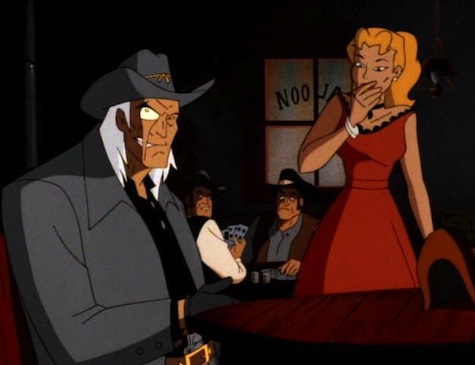
The writing crew make some interesting choices for a pilot episode. For one thing, almost everything thing we know about Hex’s background we only learn visually. The right half of his face is horrifically scarred, and he still wears a confederate soldier’s uniform in 1883, but what burned him or keeps him wearing the clothes of a defeated and disgraced cause is never even hinted at. This is also old Jonah Hex, balding with white hair and a reputation that stretches from the Utah territory to Gotham City. This is a man with a past, but he does not talk about it, so no one else is going to either. Everything else we get about his character is from Joe Lansdale’s fantastic dialogue (“you a bounty hunter?” “Just to pay for m’piano lessons.”) and veteran cowboy actor William McKinney’s dry as dust delivery. This is a man who has seen it all, and so isn’t impressed too much by anything. Lansdale wrote several Jonah Hex comics in the 90s as well, where he fought zombies, ghosts, and sandworms, so when I say “it all,” I mean, “it all.”
The voice acting in the episode in general is outstanding. Besides McKinney, who really is amazing, the always enjoyable David Warner gets to play narrator as well as declare himself “Emperor of the Americas.” It’s nice to see that Ra’s al Ghul’s ruthless justice goes back to trying to defend the West from American expansion. Malcolm McDowell, who’s always a great villain, plays Arcady Duvall, a man supremely impressed with himself, which makes him such a great foil to the world weary Hex (“I’m a Heidelberg fencing champion.” “My heart’s all aflutter.”). In her last performance, Bewitched’s Elizabeth Montgomery plays the “barmaid,” aka bordello madam, who is a font of exposition. But the oddest cameo is by President pro tempore of the United States Senate Patrick Leahy, who plays the territorial governor. Senator Leahy is apparently a huge Batman fan, and keeps being given cameos in Batman things, which is why he’s the only actor who’s been in BTAS, Joel Schumacher’s Batman and Robin, and both The Dark Knight and The Dark Knight Rises. Pull that fact out at your next trivia night.
As the first episode in a different series, “Showdown” looks and sounds different than other BTAS episodes, even with the same director, animator, and composer. The music is a lot more, for lack of a better word, “cartoony,” more exaggerated and hyper. The same is true for the animation, which is especially obvious in the “Batman” portions of the episode. The movements are more rubbery and dynamic. Of course, the whole design is very different. The episode is more pulpy than even a normal episode, incorporating cowboys, pirates, hundred year old Oriental villains, swordfights, and airships before “steampunk” was really a thing. It takes place almost entirely in daylight, in wide open spaces, rather than a cramped Gotham night. And the action is more violent. Aside from the Penguin blowing up an empty bridge, we haven’t seen mass destruction like an airship obliterating a small town. After 77 episodes of near-misses, devastation on this scale is as shocking to the viewer as it is to the Union army who’s never seen a war machine before.
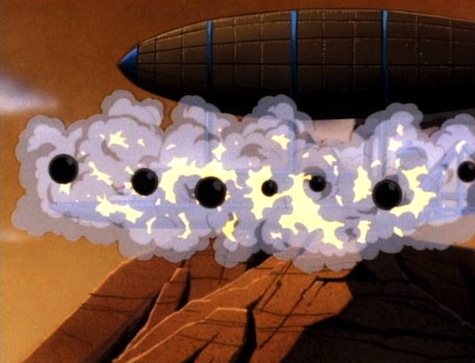
Which brings us to the problem of a Jonah Hex series. As great as a Joe Lansdale written Jonah Hex series would be, it could never get past standards and practices of Saturday morning cartoons and still be true to the character of Jonah Hex. Hex is a killer in a gritty, complicated setting. Even this episode skirts the lines of what’s acceptable in a kids show. Hex never explicitly kills anyone on screen, but he shoots a couple guys before discovering they’re bullet proof, and it’s implied he’s never brought in a bounty alive before. Additionally, they do everything they can to imply that the villain Arcady has a penchant for abusing prostitutes without ever saying those words. An ongoing series would have had to soften everything about Hex to point of making him unrecognizable. Maybe today, after Archer and The Venture Bros., Cartoon Network could air an animated series where the hero kills a dude every episode, like an animated version of Deadwood.
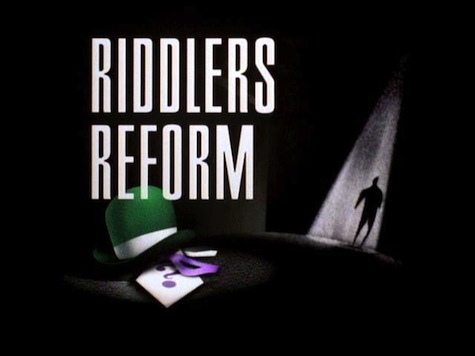
“Riddler’s Reform”
Story by Alan Burnett, Paul Dini, Randy Rogel
Teleplay by Randy Rogel
Directed by Dan Riba
Episode #079
Music Composed by Michael McCuistion
Animation by Dong Yang Animation, Inc.
Original Airdate?September 24th, 1994
Plot: The Riddler has given up crime to make and sell toys! But if he’s gone straight, why does Batman read clues to future crimes in the Riddler’s advertisements?
It’s hard for me to judge “Riddler’s Reform” as the fairly good episode it is and not be disappointed by the great episode this could have been.
What “Riddler’s Reform” gets right, probably best of all of the Riddler episodes, is demonstrating the Riddler’s motives and methods. The Riddler (this Riddler, at least) isn’t a thief compelled to leave clues. He’s a game maker compelled to commit crimes in order to get the attention of Batman, who’s the only opponent he finds worthy. When he thinks Batman is dead, Edward Nygma burns his costume. Like the Joker, he finds no reason to continue being a supervillain if Batman isn’t there to challenge him. Additionally, as he did to Mockridge in his first episode, the Riddler uses his clues to taunt and torment Batman. This time, the Riddler’s clues are sufficiently subtle that everyone who’s not Batman can’t even see there are riddles to be solved. The Riddler “gaslights” Batman, making him look like a paranoid obsessive (well, more than usual). The Riddler successfully weaponizes mystery itself. John Glover gives his usual, pitch perfect performance of a egotistical genius who delights in being smarter than everyone else, and likes being a hit with the ladies. (“You’re… adorable” he tells himself.)
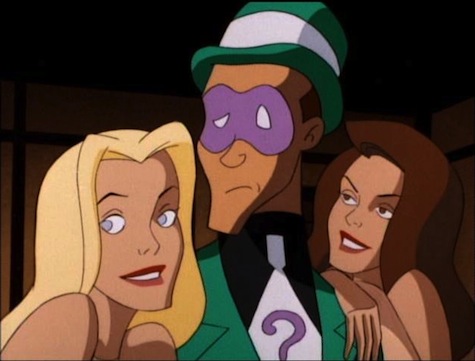
“Riddler’s Reform” also expands the Riddler’s repertoire of crime. The plot of his first two episodes come down to the Riddler kidnapping someone in order to get Batman to run his very literal mazes. Here, he’s playing a more much complicated mind game, a meta game about whether or not he’s even playing one, let alone what the rules are or if there’s a way for Batman to win. As such, instead of his usual schtick of taunting Batman from a safely remote location, Batman and Riddler have a lot more face to face confrontations, which the Riddler never moves towards being violent. The Riddler knows Batman can physically beat him. But he’s certain that he can mentally destroy Batman before it comes to that.
The tension of the episode is whether or not Batman is being paranoid. Certainly, after his experiences with Poison Ivy, and Talia, and Catwoman, Batman has every reason to suspect his rogues can’t reform. At the same time, Batman’s insistence that Edward Nygma wouldn’t give up crime for millions of dollars, international respect, and a bevy of beautiful women sounds, on the surface, to be crazy. “Trial” showed that Batman would not exist without his villains. If you didn’t know that Batman doesn’t want to be Batman, Batman’s insistence on the Riddler’s guilt could come across like an existential need. Batman needs the Riddler to be a bad guy, otherwise, Batman’s life has no meaning.
Unfortunately, Randy Rogel ruins the game by showing us halfway through that yes, the Riddler is still committing crimes so no, Batman isn’t paranoid, and with that the tension drains out. Perhaps if the POV characters weren’t Batman, who never doubts himself, and the Riddler, who obviously knows he’s guilty, and instead we saw the episode entirely from Robin’s perspective, the episode could have worked better. Robin, after all, doesn’t see clues in everything the Riddler says, and he openly questions Bruce’s conclusions. Up to the end, Robin could be conflicted in whether he should be helping Batman, or stopping him from attacking a (mostly) innocent man. Unfortunately, Robin is sidelined with a busted limb (again) so that Batman can face the conclusion alone.
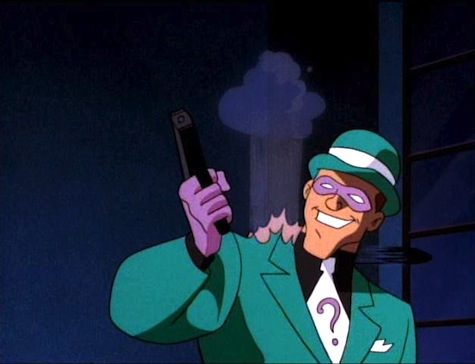
The conclusion is my other problem with the episode. As with proto-Riddler Josiah Wormwood, the Riddler is undone because he becomes obsessed with the answer to one question, how does Batman escape his inescapable death trap. So obsessed that he’s still shrieking it in Arkham in the epilogue. But Batman method of escape, hiding in a safe helpfully marked “The Safe,” isn’t that clever, really, or hard to figure out. Certainly a genius like the Riddler should have realized what Batman did, or not cared enough to give away himself to get the answer. But no, he gets obsessed with this one thing, just so the episode can have a clean ending (though using the Riddler’s own walkie-talkie toy against him, as the Riddler had used against Batman earlier, is a nice piece of turnaround.)
As the episode it is, “Riddler’s Reform” presents a nice variation on the usual Riddler plot that focuses on riddles as a weapon, rather than a weakness. As the episode it could have been, a character study on Batman, Robin, and the Riddler and a capper to the Riddler trilogy, “Riddler’s Reform” is a disappointment.
Steven Padnick is a freelance writer and editor. By day. You can find more of his writing and funny pictures at padnick.tumblr.com.










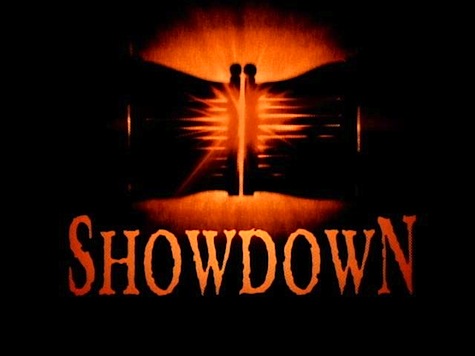
I never saw “Riddler’s Reform” as a disappointment, because it’s the only decent Riddler episode in the series. As I remarked at the time, his first two episodes tried to hard to update him into some kind of computer-game maven, an update for the sake of updating (and for the sake of making the stories more action-driven than intellectual) that took him away from his essence as a character. Plus they gave him really dumb and obvious riddles. This is the only time in B:TAS that he’s written as the subtle, intelligent puzzler he should be. And unfortunately it’s his last showcase in the DCAU; he’ll make only a smattering of appearances in The New Batman/Superman Adventures (in an ugly new costume) but never be more than a minor part of the story again.
Speaking of the extended DCAU, it’s a bit hard to reconcile Jonah Hex’s appearance here with his appearance in Justice League Unlimited‘s “The Once and Future Thing Part One: Weird Western Tales.” That story is set in 1879 and shows a Hex in the prime of his life (voiced by Adam Baldwin), while “Showdown” is in 1883 and shows a far older Hex. Then again, the Hex in JLU implies that he’s had experience with time travel before; so maybe he had more time-travel experience between the two stories.
As for “Showdown” as a story, it was interesting and offbeat for this show, an impressively made change of pace, but I’m not a fan of the kind of character Hex is, so it was more a curiosity for me than anything else.
But the way Hex is treated here to get around the censorship reminds me of how the contemporary FOX Spider-Man series handled the Punisher just a couple of months later: in both cases, the character is given an incentive to try taking his prisoner alive for a change, thus implying that he’s a habitual killer while providing an excuse for not showing it.
I love the little casting details in B:TAS. I’m pretty sure that Arcady Duvall in “Showdown” is modeled on George MacDonald Fraser’s great antihero, the rogue and coward Harry Flashman. Duvall has the same mustache and the same Heidelberg duelling scars as Flashy, and he’s portrayed by Malcolm McDowell, who was Flashman in the 1975 movie Royal Flash.
Too bad the makers of Will Smith’s version of The Wild Wild West didn’t pay more attention to Showdown to see how a steampunk Western should be done. The less said about the Jonah Hex movie of a couple years back, the better.
There’s an excellent Hex animated short on the Superman/Shazam DVD.
@3: Come to think of it, there are some surprising similarities between “Showdown” and Sonnenfeld’s Wild Wild West. I think they both involve an archvillain’s attempt to use a giant steampunk war machine to disrupt the completion of the Transcontinental Railroad.
The DC Showcase Jonah Hex short was also scripted by Joe R. Lansdale, though it was based on a comics story by other writers.
There is a much later Jonah Hex short adventure that was on a collection of other DC heroes including Green Arrow.
In it, he explicitly leaves the serial killer he tracked down to die a long and horrible death.
Oh and Senator Patrack Leahy voiced the Territorial Governor in this Batman episode.
When I saw “Showdown” for the first time, it felt very out of place for a Batman episode. It makes sense (in hindsight) that it was a backdoor pilot for a Jonah Hex series. I may have actually liked the Jonah Hex series; pity it never got made.
@3: I actually enjoyed the Jonah Hex movie. It was wild and idiotic, and fun to watch.